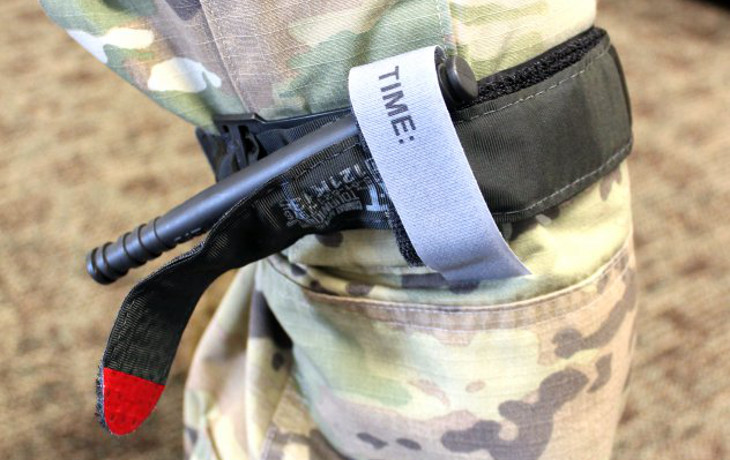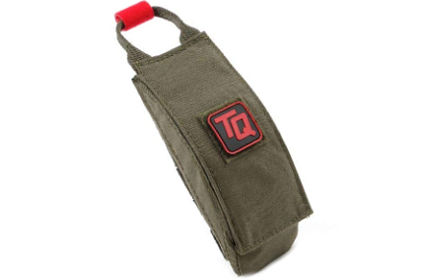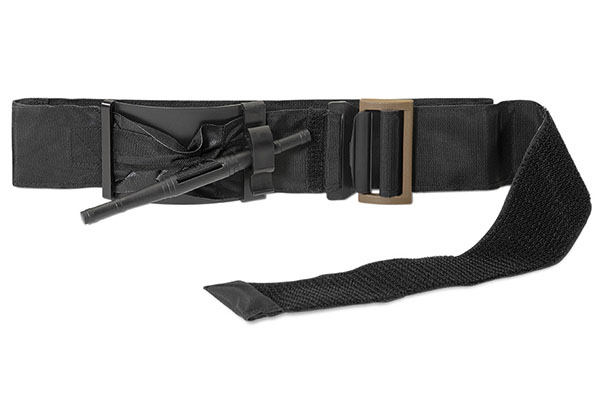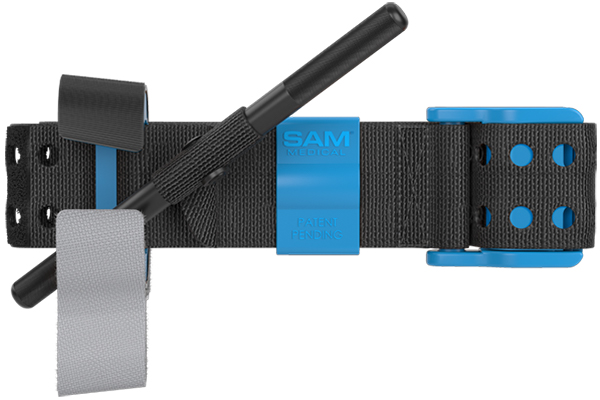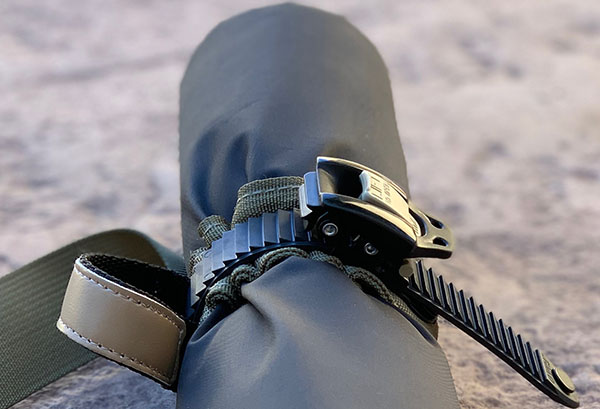Imagine you see a car accident on a rural road. The driver is injured, with a deep cut on their thigh that’s gushing blood.
In the case of a normal wound, you can apply enough pressure with your hands and bandages to control the surface bleeding. But in our hypothetical scenario, a main artery was cut and the driver will lose too much blood before an ambulance arrives. An injured person can bleed out in only a few minutes after something like a car accident or gunshot wound, so you have to move fast, and you need something more than just hand pressure and bandages — you need a tourniquet.
Tourniquets are small and simple devices that stop arterial blood loss from injured limbs in just a few seconds by pinching off the artery — similar to cutting off the flow of a garden hose by pinching the hose in half.
More: Learn when and how to use a tourniquet
These tools often make the difference between whether someone lives or dies, which is why safety experts recommend you carry at least one in each of your bug-out and get-home bags. (You might keep an extra one in your home supplies, too.) Increasingly, groups like FEMA are campaigning to raise public awareness and availability of tourniquets, so you’ll likely start to see more tourniquets in public places next to defibrillator kits.
First responders and military medics almost always have a tourniquet in their gear. Not only do elite soldiers — who are careful to keep weight down and only bring the essentials — carry a tourniquet into battle, but many keep it attached to the outside of their belt/pack/gear (sometimes in a special pouch marked TQ) so that it’s easy to find and deploy in seconds. Tourniquets are one of the few medical products with that level of “find it fast” importance.
It’s possible to make a do-it-yourself tourniquet out of common materials like cloth and sticks or with a trip to the hardware store. But the data is clear: those hacky methods are not nearly as effective at saving lives.
Modern tourniquets are affordable, well made, and worth the purchase for most people because they’re dependable and easier to use when the adrenaline is pumping.
After all… you might be the injured driver, alone, not thinking clearly, only able to use one arm to save yourself in the minutes before you pass out. That’s not the time to deal with cheap knockoffs or finding a good wooden stick for a DIY tourniquet.
Summary:
- Keep at least one of these in each of your primary kits: bug out bag, get home bag, home supplies, and car kit (if applicable).
- This is not a category to buy cheap — a $5-15 tourniquet is not good enough, and you’re better off spending that money making a DIY hardware-store tourniquet than wasting it on a knockoff product that will fail when you need it.
- The best tourniquets are only $30 and they last a long time.
- There are multiple styles of tourniquets, but only one style that’s approved in the military: the classic windlass design — essentially a solid stick that you twist to create pressure.
- The wider the surface area of the cuff, the better — narrow tubes/straps are more painful and likely to cause tissue damage.
- Normal tourniquets are for limbs only. There are special types of ‘junctional’ tourniquets for groins and armpits, but they don’t make sense for most people’s kits.
- Tourniquets are usually “one size fits most,” but will struggle with very tiny or very large limbs.
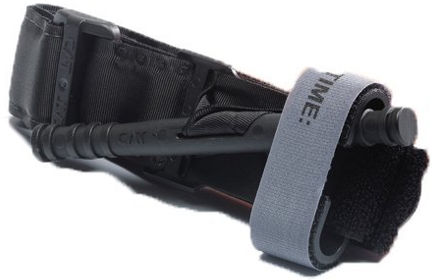
Best for most people:
CAT (Gen 7)
Our top choice for most people is the $30 Combat Application Tourniquet (Generation 7). Commonly referred to as the CAT or CAT-7, this product pioneered the modern off-the-shelf rapid tourniquet and has remained one of the leaders since. The CAT is also one of the more popular choices among preppers and first responders — and one of the few models we keep in our personal kits and use while teaching Wilderness EMT courses.
Through its latest Gen 7, CAT (distributed in the U.S. via North American Rescue) resolved the few outstanding complaints from the community: the windlass bar was strengthened and the straps/buckles were reconfigured to be even easier. Those upgrades put the CAT-7 at the top of our pile, although it was a close call with the runner-up.
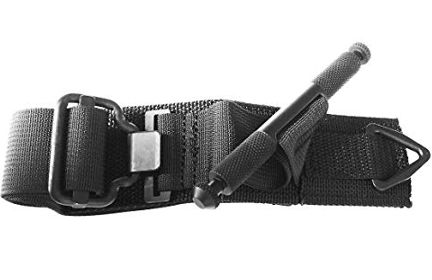
Equally-great alternative:
TacMed SOFTT-W
Also great is the $30 Tactical Medical Solutions SOFTT-W (for SOF Tactical Tourniquet – Wide). The current Gen 4 SOFTT-W is an upgraded version of the original SOFTT, with a wider strap that’s less painful and risky to use than the original model. It also fixes our original nitpick by featuring a new retention clip that works alone, or can be further secured with the tri-ring.
The SOFTT-W and CAT-7 are pretty similar — in fact, you’ll find both models among our expert’s personal kits and teaching materials. Both use the preferred windlass design, are built tough, take up the same small amount of space and weight, and can quickly and intuitively be used by normal people without too much training.
Best tourniquet pouch:
ITS TourniQuick
When seconds count, you don’t want to be digging for your tourniquet at the bottom of a crowded bag, in the dark, adrenaline pumping, covered in blood. A special holster that just holds your tourniquet in an easy-to-access location is a nice-to-have accessory. We like the new $35 ITS TourniQuick Rapid Deployment Pouch. Designed for both the CAT and SOFTT-W, you can mount this high-quality pouch horizontally, vertically, on a belt, or through MOLLE webbing.
Be prepared. Don’t be a victim.
Want more great content and giveaways? Sign up for The Prepared’s free newsletter and get the best prepping content straight to your inbox. 1-2 emails a month, 0% spam.
Why you should trust us
With a combined 83 years of field and tactical medical experience, your guides have hands-on experience applying tourniquets and managing bleeding in environments spanning the globe.
Why we didn’t recommend a “best budget tourniquet”
We didn’t pick a budget tourniquet because they’re just not worth it.
Almost every product category in prepping is at the mercy of “you get what you pay for.” In most categories it’s usually fine to save a little money by sacrificing features or quality if you’re on a budget — something is usually better than nothing.
Not so with tourniquets. We’ve personally seen budget tourniquets with 5-star Amazon reviews fail in the field for no good reason.
There are a lot of copycats and knockoffs, particularly of the design pioneered by one of our top two recommendations, the North American Rescue CAT. If it looks like a CAT but doesn’t come from NAR, or is under $25, do not buy it! Here are two common fake examples on Amazon: Mgrowth and HEPHEAS.
This video does a head-to-head test of a counterfeit vs. proper CAT using Doppler ultrasound to measure any internal pulse (one of the methods used in a proper medical certification process):
There are even Chinese knockoffs that have copied real tourniquets so well they have the US patent number embossed onto the plastic!
If your budget doesn’t allow for a proper one, go the do-it-yourself route instead. Focus more on learning the skill, and with a trip to Home Depot, you can build a tourniquet for $5 that’s better than the $15 junk.
These field-expedient tourniquets will work in a pinch, although they’ll never be as good or dependable as the real thing.
Qualities we look for when reviewing the best tourniquets
- Intuitive: If it’s been a few years since you’ve practiced, how easy can you figure things out on the fly?
- Effective: Does it actually stop blood flow when used by an average civilian?
- Durable: Quality construction that won’t break under pressure or after repeated uses
- Secure: How well it stays tight and in place when moving the injured
- Meets CoTCCC or similar medical standards
- Possible to apply with one hand
- The surface area that creates pressure on the skin should be at least 1.5” wide, which reduces pain and possibility of tissue damage
- We prefer windlass-type models
- An area/tab on the product to write down time of application (important for professionals that take over from you later)
- Made in the U.S. or a similar country with established medical certifications
The frustrating tradeoff in this market is that windlass tourniquets are the most effective type, and usually fastest to apply, but the stretch-and-tuck models are more intuitive because it’s simply a wrapping motion.
Windlass models are usually easier to apply with one hand. The wrap-and-tuck stretchy band models can be awkward, similar to putting a bracelet on your wrist with only one hand.
Tourniquets that don’t use a windlass are at a mechanical disadvantage. It can be a lot harder for an average person to create enough pressure around a large meaty leg just by wrapping and tucking stretchy rubber. The windlass is what gives you leverage, like lifting something heavy with a pulley or folding a garden hose in half instead of pinching the tube with your fingers.
We’ve seen a wide range in the build quality of tourniquets. By design, tourniquets place a tremendous amount of pressure on a few small pieces for a few hours straight. A common problem, for example, is cheaply-made windlasses that fold under pressure, and if the windlass collapses, there’s nothing holding the tension you wound up.
Medical standards matter
The best tourniquets meet standards set by the independent Committee on Tactical Combat Casualty Care (CoTCCC), which is endorsed by the American College of Surgeons and the National Association of EMTs.
All of the tourniquets we recommend are approved by the CoTCCC.
In many product categories, “approved by” doesn’t mean much beyond a higher price tag. But in this case, approval by the relevant standards body is important because these medical devices have undergone rigorous evaluation in the field, combined with a ton of after-action analysis by professional medics. Testers even use doppler (think of it like sonar or an x-ray) to look inside a real body under tourniquet to check that the blood flow has stopped.
Unfortunately, some commonly-seen manufacturers played games by creating a for-profit TCCC trademark so they could put “TCCC Approved” on their products without going through the certification process. This was settled out of court in 2016, but it’s always possible to find more sleazy games.
Note: On May 6th, 2019, the CoTCCC released their new “Recommended Devices & Adjuncts” which included several new tourniquets — the first time they have added new tourniquets since 2004.
The competition
We’ll only ever consider recommending tourniquets approved by the Committee on Tactical Combat Casualty Care (CoTCCC). In May 2019, CoTCCC expanded the list from two to eight:
The NAR CAT and TacMed SOFTT-W are the two original approvals. Although, the generations have changed over time, and in the 2019 CoTCCC updates they dropped the original 1-inch wide SOFTT because narrow bands don’t safely control hemorrhage. That’s why TacMed released the SOFTT-W (for “Wide”). The older CAT Gen 6 is still approved, but they’re getting harder to find and don’t provide value over the Gen 7.
Combat Medical TMT Tactical Mechanical Tourniquet. Although not enough to overtake the two main picks, the newly-approved $30 TMT has a few benefits over the winners. The TMT is two inches wide (compared to 1.5-inches on the CAT and SOFTT-W). The torsion bar (what TMT calls the “windlass”) retention features a tactile and audible confirmation when it is secured. Lastly, the velcro does not need to be attached to secure the strap — the buckle locks down.
The downside that we found in our preliminary testing is that the windless must be rotated in the clockwise direction to secure in the retention clip consistently. Other models don’t care about the direction. During a self-application session, the TMT unwound and released the pressure because we had turned the windless counter-clockwise and lost grip while trying to secure in the retention clip.
SAM XT Extremity Tourniquet. From the same company that makes the SAM Splint (one of our favorite first aid kit items). The SAM XT features an auto-locking buckle that helps the user eliminate the slack in the band. One of the reasons windlass type tourniquets “fail” is not due to materials, but because the circumferential strap is not pulled tight enough — the SAM XT’s buckle makes it easier to get the strap tight and keep it that way.
The SAM XT also features a metal windlass, and the strap is a single-piece construction rather than a sleeve like the CAT. The function is smooth and consistent, but the tourniquet is exceptionally bulky compared to the CAT and SOFTT-W.
m2 RMT Ratcheting Medical Tourniquet, RevMedx TX2, and RevMedx TX3. Made by the same company (m2), but the TX2 and TX3 are marketed by RevMedX. These are the first ratcheting tourniquets approved by CoTCCC. While we like the positive mechanism of the ratchet and think it is easier to perform than twisting a windlass, we are still hesitant to recommend this type of tourniquet.
The material beneath the ratchet bunches up and doesn’t provide smooth contact throughout the circumference, which can significantly increase discomfort. Also, none of the new ratcheting models offer a truly one-handed application — you must use the “tactical bite loop” to provide a counter anchor for the strap when tightening.
Although not contenders, we wanted to list common tourniquets not approved by the Committee (or who haven’t applied for approval) so you know what’s out there:
H&H MET Military Emergency Tourniquet (Gen 3). A buckle-less, windlass tourniquet that’s deployed as an open loop, requiring the user to thread the end through a couple of sleeves prior to cinching. One claimed benefit is that the user does not have to fully tighten the strap of the MET before engaging the windlass — which is required with tourniquets like the CAT.
H&H SWAT-T. The SWAT-T (Stretch Wrap And Tuck Tourniquet) is the most popular in the elastic tourniquet category and sometimes found among preppers. In the end, we just don’t see any benefit to it over the more common models.
H&H TK-4. The TK-4 is a 2-inch wide, woven elastic band tourniquet that features two steel hooks anchored on the ends. While it compacts down to a small size, the TK-4 is challenging to put on while under stress and consistently apply enough pressure to manage a bleed.
PYNG MATCombat / MATResponder. The MAT uses a “turn-key” system for constricting. The current generation resolves a number of problems with the first generation: breakage and extreme discomfort to the patient. Note: As of December 27, 2021 this item has been discontinued
RATS Rapid Application Tourniquet System. The RATS is a well-marketed but controversial elastic tourniquet. While it is light and small, the RATS is not the best choice for most people, and we disagree with some of the choices the company has made while promoting their product.
Recon Medical Tourniquet. Considered to be a clone of the North American Rescue CAT. While not approved by the CoTCCC, if you can’t afford the CAT, this would be the best budget choice and far superior to the counterfeit CATs or elastic tourniquets.
Tactical Medical Solutions K9 Tourniquet. The K9 Tourniquet is designed to work on the tapered limb of a canine and is not recommended for human use. Some preppers have purchased the K9 Tourniquet for use on children under misinformation that the CAT or SOFTT-W will not work on smaller limbs. In fact, both a CAT and SOFTT-W will work on canines if placed correctly.
Thor TQ. Ratcheting. It appears to have a better one-handed application than any of the other ratcheting models, but it is not yet available to purchase — we’ll update this review once we’ve had our hands on it.
Types of tourniquets
Windlass
Windlass models are essentially a webbing loop/sleeve that wraps around or slides onto a limb, combined with a solid bar (the windlass) you can easily grab, twist to create pressure, and lock in place.
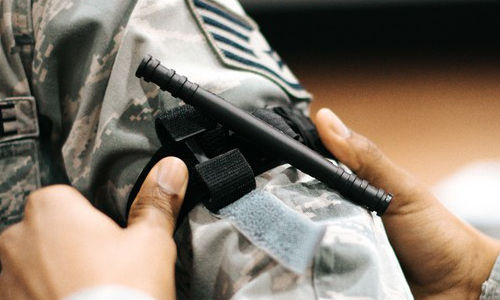
Most models have a latch or loop that holds an end of the windlass bar, preventing it from unwinding. In the picture above (the CAT Gen 7), the tip of the windlass slides into and is held by one of the two opposing plastic slots (near the medic’s left thumb). The velcro tab hanging below is then wrapped over top for extra security.
Ratcheting
Picture the common straps and ratchets used to tie down heavy loads on a truck bed. Ratchet tourniquets are similar. Some use a wind-up drum, just like truck ratchets, while others use a system more like your common household ratchet wrench or the buckles on ski boots.
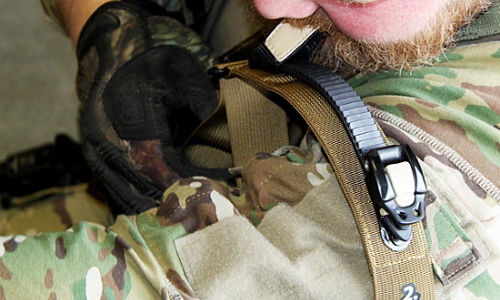
The US Army Rangers tested a ratcheting version in the field in the 2000s but went back to the windlass style. There were too many points of failure, such as clothing/skin/blood getting stuck in the ratcheting mechanism. Modern models don’t appear to suffer from this problem, though, and the first ratcheting tourniquet was approved by the CoTCCC in 2019.
Elastic band
Very similar to flat elastic exercise bands or round surgical tubing, elastic band tourniquets are basically just a long piece of stretchy material that you forcefully wrap around a limb a few times. You might see them referred to as a “wrap and tuck” or “stretch” tourniquet.
(Warning: graphic gore)
Some people say elastic models are easier to use than windlass models. We think that can be true in a practice setting, but we find that’s not the case in the field, and they’re definitely more difficult to use one handed than windlass types.
When you’re trying to find the sweet spot for tightness, we prefer the windlass because the risk is lower and it’s easier to make smaller adjustments without the whole thing unraveling.
Pneumatic
Pneumatic models use an inflatable bladder to squeeze off blood flow. In fact, a common blood pressure cuff is a form of tourniquet. But you generally don’t see these kinds outside of hospitals, and we don’t recommend them for average preppers.
Holsters and storage
It’s important to be able to access your tourniquet in seconds. You don’t want to be fumbling through a backpack or medical pouch as someone is rapidly bleeding out in the dark.
Remove your new TQ from any packaging as soon as you receive it. You may also want to re-fold the product so it stores with a flatter profile:
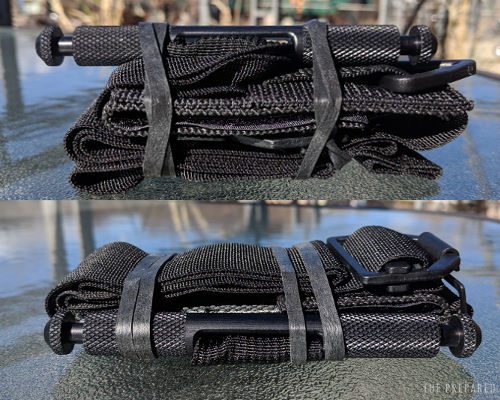
Because many people keep the TQ strapped to the outside of their pack/gear, the top models come with UV-resistant rubber bands (typically black) that won’t break from sun exposure. Don’t toss them out with the disposable packaging.
You may also want to re-fold the product so it stores with a flatter profile.
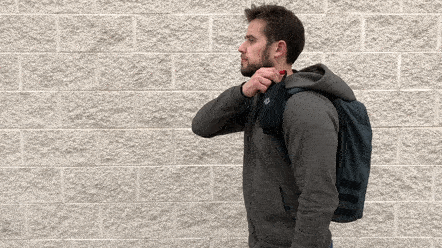
If possible, keep your tourniquet stored away from your limbs. You may see pictures of soldiers that rubber band their TQ to the front of a shoulder strap on their backpack or body armor, near the armpit. But if you’re injured in the upper arm (one of the few areas on your body a tourniquet actually helps), you don’t want your TQ to be damaged at the same time.
